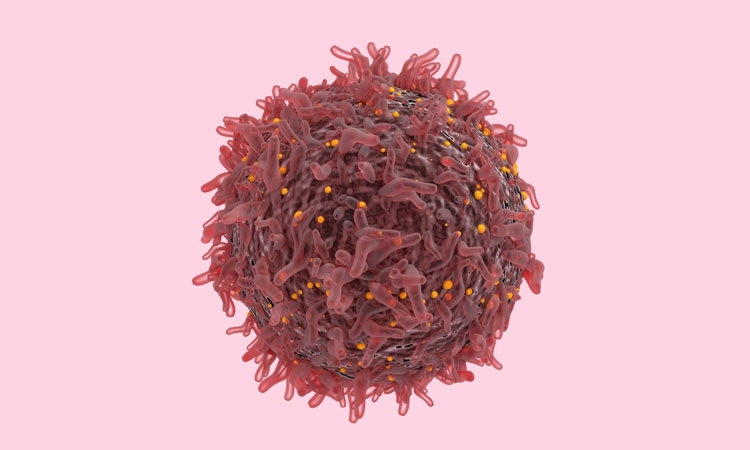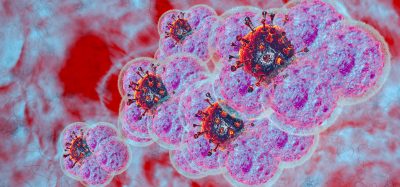Bioengineered instrument reveals hidden cancer cells
Posted: 11 September 2023 | Taylor Mixides (Drug Target Review) | No comments yet
Scientists at Stanford University have engineered a biomolecule that can specifically remove mucins from cancer cells. This breakthrough could have a significant impact on future cancer therapies.

Cancer cells can elude the body’s immune defences by manipulating a group of molecules known as mucins, which are typically helpful and widespread.
Mucins are proteins covered in sugar that primarily protect the body against physical harm and pathogens. However, cancer cells exploit mucins to support their survival. While the concept of removing mucins from cancer cells seems promising, mucins are present in various forms on all mammalian cells. Therefore, targeting them indiscriminately could lead to unforeseen side effects.
The solution devised by the Stanford research team involves creating a biomolecule that combines an enzyme-based “scissors” called mucinase (a type of protein-cutting enzyme known as a protease) with a cancer cell-targeting nanobody (a fragment of an antibody). This two-part biomolecule specifically targets and trims mucins linked to particular cancer cells.
This study, conducted using human cancer cells grown in a lab and mouse models mimicking human breast and lung cancer, revealed that the biomolecule treatment notably reduced tumour growth and increased survival rates. Their findings, published in Nature Biotechnology, have broad applications as mucins are associated with many diseases, including cystic fibrosis, respiratory diseases, and viruses.
Senior author Carolyn Bertozzi commented, “We discovered that by targeting this mucinase to cancer cells and using it to remove mucins from those cells, we achieved therapeutic benefits.”
Graduate scholar Gabrielle Tender is a co-lead author of the study alongside two former researchers from Bertozzi’s lab. Understanding the transformation of beneficial mucins into harmful agents Although mucins are typically beneficial, cancer cells exploit them for detrimental purposes. When mucins turn harmful, the consequences are severe.
Tender explained that mucins have vital roles throughout the body, such as generating mucus in our respiratory system and gastrointestinal tract, safeguarding us from pathogens. Cancer cells amplify this natural process to protect themselves and propagate within the body.
This study explored two functions of mucins associated with promoting cancer progression. Firstly, mucins help cells endure in environments with minimal adhesion to surfaces.
Bertozzi noted that cancer spreads and metastasizes within the body – cancer cells detach, travel to different areas, and establish themselves. Cancer cells on the move need to survive in low-adhesion conditions. While most cells can’t do this, cells modified by mucins have this capability.
The second function involves mucins binding to checkpoint receptors, which are like sentinels of the immune system, inspecting cells within the body. Certain cancer cells decorate their surfaces with mucins coated in specific sugars that effectively attach to these receptors. This sugar-coated mucin binding to checkpoint receptors signals that the cancer cell poses no threat, consequently blocking the immune response.
Tender elaborated that these results in immune cells ignoring the cancer rather than eliminating it, as they normally would. The journey to success the scientists’ mucin-targeting biomolecule consists of two components fused together. The first part is a mucinase derived from bacteria, capable of cleaving mucins. The second part is a cancer-specific nanobody that binds to a corresponding antigen on cancer cells.
Bertozzi, the Baker Family Director of Sarafan ChEM-H, explained that the nanobody positions the mucinase on the cancer cell. This technology is part of their broader program at Sarafan ChEM-H focused on proximity-based medications. Proximity-based medications channel specific biomolecules to a designated region to facilitate desired chemical reactions.
The team extensively researched bacterial proteases that cleave mucins. These “mucinases” cut when they encounter specific arrangements of amino acids and sugars within mucins. For this study, the researchers selected a mucinase named StcE (pronounced “sticky”), sourced from the bacteria E. coli.
While bacterial enzymes are already used in treating cancer, such as childhood acute lymphoblastic leukemias, mucinases have not been tested as injectable therapeutics. Thus, the team needed to ensure the safety and effectiveness of the StcE mucinase. Testing the StcE mucinase in mice revealed its efficacy, but it indiscriminately affected mucins throughout the body, emphasising the necessity to target the mucinase to tumour-related mucins.
Prior research by Bertozzi’s team and others demonstrated that combining antibodies with enzymes can direct their activity toward specific cells. However, this requires adjusting the enzyme to ensure it only acts near its target. After numerous mutations of the StcE mucinase, the team developed a version known as eStcE (“engineered sticky”) that met their requirements.
The researchers selected a nanobody called 5F7 for their biomolecule since it is extensively studied and corresponds to the HER2 antigen linked to breast, ovarian, and other cancers. The team designed two variations of the eStcE mucinase-HER2 nanobody combination, testing each for stability, yield, mucinase activity, and binding capability. The most effective version was nicknamed αHER2-eStcE.
Subsequently, the αHER2-eStcE biomolecule was assessed to determine if it specifically targeted and eliminated the target cancer cells in a series of experiments conducted in lab dishes. Following this, the researchers confirmed the biomolecule’s effectiveness and lack of toxicity through two separate studies involving mice. The first study simulated metastatic lung cancer, and the second mimicked human breast cancer, with tumours located in the breast area of mice.
These investigations demonstrated that the αHER2-eStcE biomolecule effectively acted on both tumour-associated mucins and metastasizing cells. In the mouse studies, the αHER2-eStcE treatment notably reduced cancer growth and increased survival compared to the untreated control group.
The path ahead While this study is a significant stride in cancer research, it hasn’t yet led to a new cancer therapy for humans.
Bertozzi remarked that one major future step is to determine if they can create a comparable targeted mucinase using a protease sourced from humans. The one used in this study is not derived from humans, which raises the risk of an unwanted immune response.
Tender is currently focused on developing a human-derived mucinase. Although more research is necessary, this study represents a noteworthy advancement in cancer research.
Tender commented that for years, evidence from cancer patients and experiments has indicated the significance of mucins in cancer, but they previously lacked effective means to eliminate these mucins.
Related topics
Cell Therapy, Immunology
Related conditions
Cancer
Related organisations
Stanford University






